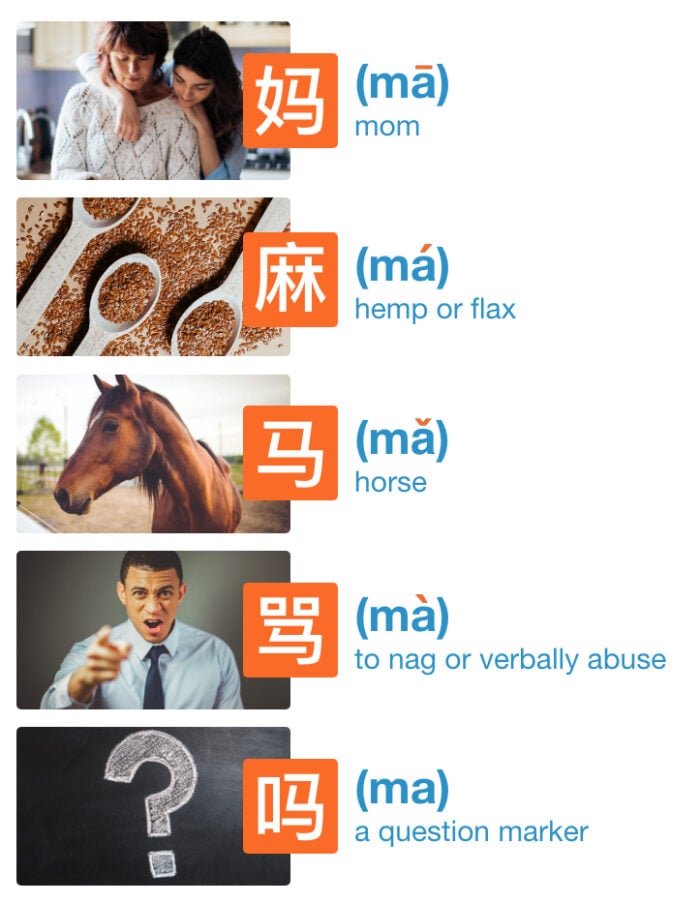Chinese Tones: What They Are & How to Master Them
Have you decided to start learning Chinese? Well done. Learning Mandarin Chinese will allow you to communicate with hundreds of millions of people not just in Asia but across the world.
Besides, in recent years, China has become arguably the largest economy in the world, which means that there is a huge demand for people who can bridge the gap between this new China and English speaking countries.
Learning how to use business Mandarin Chinese might open very big doors for you, so what can you do to improve your communication skills? Easy. After you’ve learned the Chinese alphabet, the first thing you’ll need to do is learn Chinese tones.
Table of Contents
What Are Chinese Tones and Why Are They Important?
Chinese Tones and How to Use Them
1. First Tone (Flat Tone)
2. Second Tone (Rising Tone)
3. Third Tone (Dip Tone)
4. Fourth Tone (Falling Tone)
5. Fifth Tone (Neutral Tone)
Tips to Learn Chinese Tones
Step 1: Watch the Say It Right Series
Step 2: Tone Drills
Step 3: Record Yourself!
Step 4: Learn Chinese tones by practising commonly confused words!
Book a Free Trial Class with a qualified native-speaking Chinese tutor!
What Are Chinese Tones and Why Are They Important?
Mandarin Chinese is a tonal language, which means that tones are used to define the meaning of a word. There are five different tones for this: flat, rising, dip, falling, and neutral.
Tones are not a completely new concept for English speakers. Actually, we use them all the time. Whether we want to show doubt, be ironic, inquisitive or assertive, we use different intonation patterns to mean different things.
The difference is that the use of tones in Mandarin Chinese is slightly more extreme than that, and can completely change the meaning of what you are saying.
You can see why it’s important to learn how to use Chinese tones correctly and why you should never underestimate their power! If you want to interpret what other speakers are saying and you want to be understood yourself, using the right tone is not an option. It’s a requirement.
Still unconvinced? Let’s look at an example then. Consider the following words:

While all of them look as if they sound the same (if you read the Latin letters, also known as Pinyin in Chinese), they are said with different tones. It is the intonation, and not the sounds, which gives these words their meaning.
Chinese Tones and How to Use Them
1. First Tone (Flat Tone)

The first Chinese tone you should learn is the flat tone. It’s made when your voice becomes high and level. As its name indicates, it’s a flat tone, so you need to keep your voice even and your pitch up.
Syllables said with this tone should be pronounced with a drawn-out voice that doesn’t drop or rise throughout the whole segment.
As with all Chinese tones, the Flat Tone is represented by a symbol written above the vowel. In this case, it’s a straight horizontal line, although you might also see a number “1” after the flat syllable in question.
Example: 妈 (mā) — mother.
2. Second Tone (Rising Tone)

Do you remember we said Mandarin Chinese tones were not so different from English ones? Well, the Rising Tone describes a pitch movement similar to the one we make to ask yes/no questions in English.
Try saying “Did you remember to pay the bills?”. Do you notice how your voice rises throughout the question? Similarly, the Rising Tone involves a moderate rising of your pitch to convey meaning.
Now that you know how to use it, let’s see how to write it.
The Rising Tone is represented by a rising dash above a vowel, or by a number 2 written after the syllable.
Example: 忙 (máng) — busy.
3. Third Tone (Dip Tone)

The Dip tone is one of the most challenging for Mandarin Chinese learners. To produce this tone, your pitch has to go down to quite a low point before rising again.
In English, we sometimes use a fall-rise tone at the end of statements to imply that we are unsure, or to signal that we may have more to add: I don’t want to go out with anyone at the m↘om↗ent (implying that this might change in the future).
In pinyin, the third tone is represented by a dip above the vowel: 我 (wǒ) — I/me, and (or occasionally by a number “3” placed after the syllable).
Example: 我 (wǒ) — I/me.
4. Fourth Tone (Falling Tone)

The Falling Tone starts high but drops sharply to the lowest area of the tonal range. To pronounce it correctly, you have to say the word forcefully, letting your pitch drop all of a sudden. Of all Chinese tones, the 4th tone also tends to be the shortest in duration.
English-speakers can associate this tone with a command said in an angry voice, so don’t be afraid to emphasise this one by making it sound a bit imperative.
The Fourth Tone is represented by a dropping dash above a vowel (or sometimes by a number “4” written after the syllable).
Example: 是 (shì) — to be.
5. Fifth Tone (Neutral Tone)

Of all Chinese tones, this is the most controversial one, as whether it is a tone at all is actually up for debate. Instead of raising or dropping your intonation, this one is simply neutral.
Now that we’ve told you how to use it, let us share some good news: as there is nothing to change or emphasise, Pinyin doesn’t mark the Neutral Tone at all.
Example: 吗 (ma). This is a question particle that turns affirmative phrases into yes/no questions and is pronounced with a neutral intonation.
Tips to Learn Chinese Tones
Step 1: Watch the Say It Right Series
Reading about Mandarin Chinese and its tones is all very good. But if you really want to know how to use them you will need lots of acoustic exposition. The Say It Right series is a fantastic YouTube channel that will take you through the essentials of Chinese tones.
Although it might be easy to produce and recognise tones in isolation, soon you will find that these change when they are followed by a different tone. The Say It Right series will guide you through all these tonal changes and combinations step by step!
Step 2: Tone Drills
You still have a hard time getting those tonal pairs right? Then try drilling them for 5-10 minutes a day for a couple of months. Though it might seem an old-fashioned thing to do, repetition helps you solidify knowledge in your brain like no other method does.
So prepare a few colour-coded flashcards, write down examples of all five Chinese tones and their different changes and combinations, and drill them every morning before going to work.
Step 3: Record Yourself!
We know. No one really likes listening to their own voice. However, it can’t be denied that recording yourself is a great way to spot frequent mistakes and assess your own progress.
Why don’t you do this? Find a great extract from a book, write it down, mark all the tones with different colours, and record yourself reading it out loud. After you’ve finished, listen to yourself and see which tones you got right and which ones need improvement.
You can also wait a few months, record the same extract again, and compare the two versions. We’re sure you’ll be amazed at how much progress you’ve made.
Step 4: Learn Chinese tones by practising commonly confused words!
Here is a short list of pairs of words people mix up that will help you practise the differences between the five tones in words that sound very similar otherwise!
Swimming/To swim (游泳 yóuyǒng) – Useful (有用 yǒuyòng)
To have dinner (吃晚饭 chī wǎn fàn) – To finish your meal (吃完饭 chī wán fàn)
Often (常常 chángcháng) – To taste (尝尝 chángchang)
Dumplings with soup (水饺 shuǐjiǎo) – To sleep (睡觉 shuìjiào)
To know (知道 zhīdào) – A guide (指导 zhǐdǎo)
As you can see, there’s much more to Chinese than Chinese characters. If you really want to improve your speaking skills, learning Chinese tones is a must.
And if you’re a truly conscientious student who loves learning about the origin of languages, don’t miss our post on the history of the Chinese language.
Do you really want to get fluent in Chinese? Then your best option is a personalised course with a native Chinese tutor. Send us a quick enquiry now and we’ll make sure you get a quick answer with detailed info about our unique methodology.
Book a Free Trial Class with a qualified native-speaking Chinese tutor!

